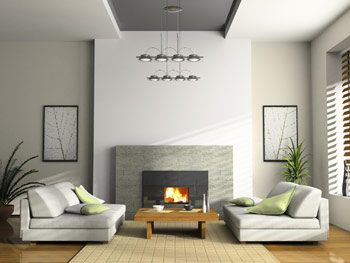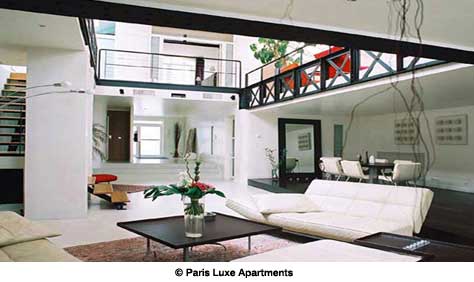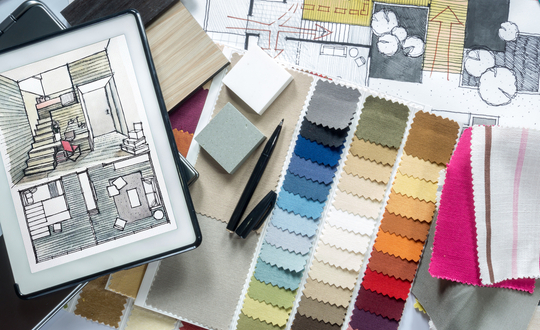Fabulous design. Cutting edge looks. Interesting twists in color, fabric, and texture. These are all elements inherent in design that's ecologically sound. Yes, your creativity can have free reign even as you make choices that help protect the planet. Increasingly, manufacturers are creating products that have minimal impact on the environment, whether because they're made from organically-grown cotton or because they're made with renewable resources. We think environmentally friendly design is so important that we recently added a Green Design lesson to the NYIAD Complete Course in Interior Design.
In our "Decorating Green" column we'll look at a sustainable, low-impact element of design in each issue of "Designer Monthly." We hope these articles will help us all help the planet and the many creatures that share it with us.
Green is the new black…and we don't mean the color. Everywhere you look from Hollywood stars to designers to everyday moms — all are promoting eco-friendly practices and materials. Grocery shoppers are shunning the plastic bags and bringing their own canvas bags to hold the groceries. Some cities and countries (read: San Francisco, Ireland, China) have even banned them in large chain stores. In the beleaguered auto industry, hybrid cars that combine gas and electricity for fuel — such as the Toyota Prius — have become the top-selling models. People are also throwing around the terms "carbon footprint" and "carbon neutral" at cocktail parties.
But what does "eco-friendly" mean when applied to your home? We already know that using compact fluorescents instead of incandescent bulbs will reduce your energy bill — but what else can we do? We went to the industry professionals and found out what the leading architects and interior designers are preaching and practicing. We boiled down the green principles to the following:
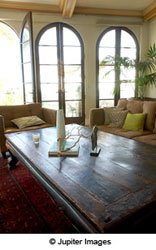
- Sustain.
- Recycle.
- Reuse.
- Reduce.
- Non-toxic.
In other words, to create an eco-friendly home, one should use materials that are sustainable, recycled, or reusable and non-toxic to people and animals and one should reduce the amount of products being used. Sustainable materials do not deplete scarce earth resources — such as trees. An example of a sustainable material is bamboo wood. Bamboo is really a large grass — not a tree — and can be quickly replanted without depleting the species. Recycled materials are made from existing products which are broken down into raw materials and made into new items — an example are glass tiles that are made from glass bottles rescued from the landfill. Reusable materials are those that can refilled such as refilling ink and toner cartridges or materials used again in a new function — such as old wood floors that are reused by creating tables out of the wood.
You can also reduce your acquisition of "new stuff". For example, instead of buying new furniture or new toys — why not find a vintage thrift store and find what you need there and then turn around and donate the stuff you don't need any more to Goodwill. Lastly, using non-toxic materials that do not off-gas is beneficial to everyone's health.
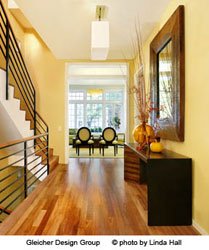
LEED-accredited architect Paul Gleicher is one of the green-friendly architects, who we discovered, truly practiced what he preached. He turned his new home — an old New York City townhouse — into his personal green laboratory. The townhouse needed a renovation anyway so he set out to transform it from top to bottom to an eco-friendly home.
First, Gleicher replaced the flooring with an eco-friendly hardwood called Lyptus. Lyptus wood is a hybrid,
crossbred between two eucalyptus trees to create a tree that can reproduce quickly from a stump without
replanting when it's harvested. Other architects and designers also recommend bamboo as another eco–friendly
wood choice for flooring but Lyptus is even denser than bamboo and can take abuse especially in a house
full of children. For their walls, he made sure to use zero-VOCs paint. VOCs are volatile organic
compounds which are absorbed into the air and create smog and respiratory problems such as asthma.
Examples of zero-VOC paints include Sherwin Williams' Harmony paint line and Benjamin Moore's Natura line.
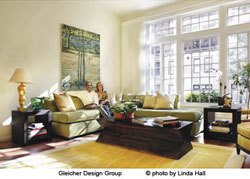
When Gleicher replaced the windows, he used low-e coated insulated glass with argon-filled cells. These low-e (or low emittance) coated windows reduce heat loss but admit solar gain and are best for homes in northern climates.
In furnishing their homes, he and his wife, Lisa Sharkey, bought mostly furniture made from recycled woods. For those pieces that weren't from recycled woods, they made sure the wood was FSC-certified and did not emit formaldehyde. FSC (Forest Stewardship Council) certification is given to forestry companies who meet specific standards in forest conservation.
To upholster their sofas and chairs, they used post-consumer recycled fabrics from Pollack. To give some pizzazz to their fireplace and still be environmentally green, they surrounded it with Icestone, a surface material made from recycled glass embedded in concrete. Icestone can also be used for kitchen countertops and bathroom vanities.
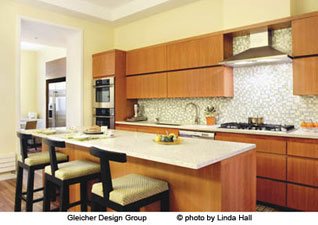
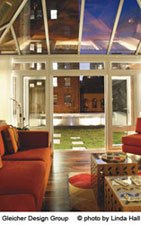
Their efforts did not end with the interiors of their home — Gleicher also created a green roof on top of their townhouse. Green roofs have been found to lower the temperature of the building during the summer by absorbing the sun's rays. It can reduce a building's cooling needs by as much as 25%. Besides reducing energy costs, a green roof is found to have double the lifespan of a conventional roof.
Interior designer, Robin Wilson, has advised her clients who need insulation in their walls to use blue jean insulation. Normally, contractors have used fiberglass insulation but fiberglass can be an irritant when exposed to skin. By using blue jean insulation which is created from postindustrial-recycled denim, homeowners can avoid the glass fibers in ordinary insulation. Blue jean insulation has also been found to hold more heat and absorb more sound. The company that offers blue jean insulation is Bonded Logic from Arizona.
Wilson also recommends using bamboo or beech sheets. Both are hypoallergenic and help asthma sufferers. There are also new fabrics that are eco-friendly and made from coconut, pineapple, and corn husks.
Another designer, Patricia Gaylor, advocates replacing your regular shower heads and toilets with low-flow showerheads and dual-flush toilets — thus conserving water use. If you are renovating your kitchen or bathroom, Gaylor suggests instead of throwing out the old cabinets and fixtures and adding to landfill to "freecycle" or donate them to Habitat for Humanity.
In addition to using green-friendly materials, following eco-friendly habits will also help. Besides using compact fluorescents to reduce energy consumption, you can do another simple thing to reduce electricity — transfer all your electronics to a strip outlet and then turn off the switch before you leave your home. Then just turn it back on when you get back home later in the day and you will see savings by the end of the year. Electronics these days still consume "phantom power" even when they are turned off. By using strip outlets, phantom power will be eliminated.
Old habits do die hard but if you just think of the following green words as a mantra: "sustain, recycle, reuse, reduce, non-toxic" before making any purchase, you will go a long way in developing new eco-friendly habits and contributing to a greener earth.


